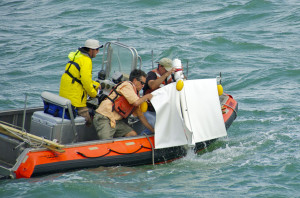GLAD
Grand LAgrangian Deployment
Visit the GLAD Blog for daily updates from the field.
The Grand LAgrangian Deployment (GLAD) was the largest-scale experiment of its kind in the Gulf of Mexico. During August 2012, Dr. Brian Haus (University of Miami) and his research team deployed over 300 custom-made drifters near the Deepwater Horizon site and Louisiana coast.
In light of the Deepwater Horizon oil spill, it became clear that understanding the multi-scale interactions among small, large, and sub-mesoscale oceanic flows lies at the very heart of being able to improve our understanding and prediction of oil spills – T.Özgökmen
The release of drifters during GLAD was an essential first step to study the complex and elusive surface ocean currents that transport pollutants. Using GPS satellite positioning, the specially designed drifters reported their positions every five minutes – a rate not achieved before in an experiment of this magnitude – resulting in over 6 million data points! The Naval Research Laboratory supplied thirty-two realizations of Navy Coastal Ocean Model (NCOM), running at one and three kilometer resolution to provide seventy-two hour forecasts. CARTHE investigators used a fully coupled ocean-wave-atmosphere modeling system for real-time data processing. These detailed data were essential in determining more precisely where the drifters should be launched according to ocean features.
CARTHE used two research vessels to collect the data they needed to improve predictive models. Dr. Haus led the drifter deployment onboard the R/V Walton Smith . Dr. Brad Rosenheim at Tulane University led sediment and water sampling along select Florida panhandle beaches onboard the RV Pelican.
 Data from the drifters will help scientists understand the role of near-surface ocean flows in spreading and dispersing oil. Researchers will study interactions among ocean flows, the levels of influence on transport that large and small flows have, the size of oil spread at which large flows dominate, and the length of time that large flows control the direction oil will travel.
Data from the drifters will help scientists understand the role of near-surface ocean flows in spreading and dispersing oil. Researchers will study interactions among ocean flows, the levels of influence on transport that large and small flows have, the size of oil spread at which large flows dominate, and the length of time that large flows control the direction oil will travel.
Data from short sediment cores and water samples will help scientists verify the presence or absence of oil and the type of weathering that has occurred to the oil in both the sedimentary and shore-line water environment. Researchers will also learn about the contribution of old carbon or oil from other sources at different water depths.
 For the first time, CARTHE’s field work at sea, combined with laboratory experiments and development of interconnected modeling systems, will produce a comprehensive modeling hierarchy that provides a four dimensional description of oil/dispersant fate and transport in the Gulf of Mexico and coastal environments across all relevant time and space scales.
For the first time, CARTHE’s field work at sea, combined with laboratory experiments and development of interconnected modeling systems, will produce a comprehensive modeling hierarchy that provides a four dimensional description of oil/dispersant fate and transport in the Gulf of Mexico and coastal environments across all relevant time and space scales.
This research was made possible by a grant from The Gulf of Mexico Research Initiative (GoMRI). The GoMRI is a 10-year, $500 million independent research program established by an agreement between BP and the Gulf of Mexico Alliance (GOMA) to study the effects of the Deepwater Horizon incident and the potential associated impact of this and similar incidents on the environment and public health.



